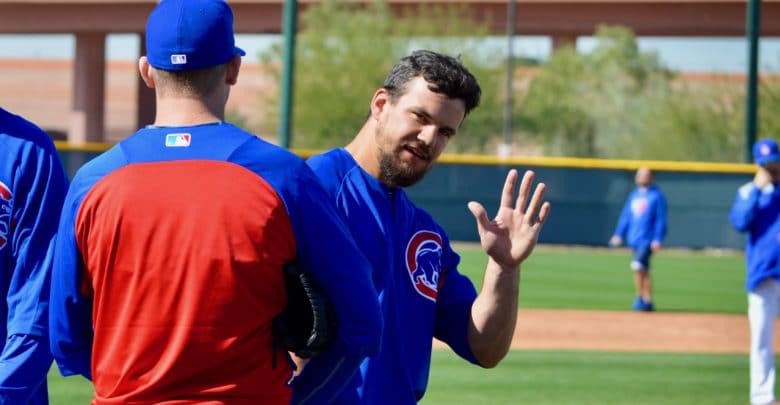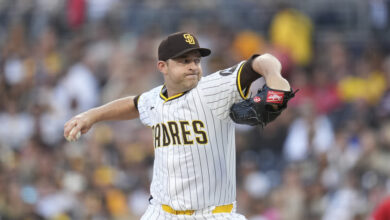
Cubs Beat Writer Thinks Schwarber, Happ, Chavez Likely Gone
Since at least early last season, we’ve been aware of the Cubs’ eventual need to trade from their position-player depth in order to address organizational needs. Nearly a year and a half later, the young core is still fully intact and there really aren’t any upper-tier prospects with both high value and redundant talent. So what do the Cubs do?
Theo Epstein and Jed Hoyer have both made very frank assessments of what was supposed to be an elite offense, lamenting the inconsistency and lack of urgency that led to disappointing results. Epstein admitted that the offense “broke” and vowed to put all his energy into fixing it. And unless he’s got some kind of psychic power, which I’m not necessarily willing to deny, that means making personnel changes.
One of the problems, and I’m no longer using that in a sarcastic sense, with the Cubs over the last two seasons is that they’ve almost got too much overlapping talent. While depth and flexibility are strengths to an extent, they can become detriments when they impede the development of young players.
Even if you don’t subscribe to that notion, the simple reality is that you can’t add new players without subtracting others. Taking that a step further, you can’t simply add the type of solid, everyday performers who will mend flaws in your team without letting go of some other everyday performers. As great as it’d be to carry 25 non-replacement players, it’s just not feasible.
Where the Cubs are concerned, that means parting with some players who have been instrumental in elevating them from never-rans to 387 wins in four seasons. And the Tribune’s Mark Gonzales, who’s been on the Cubs beat for over five years now, has a fairly good idea of who could be on the way out.
Most of pitchers he lists as “likely to depart” come as little surprise, though Jesse Chavez might raise an eyebrow or two. He said after the Wild Card loss that he’d rather retire than play for another team, though one wonders how steadfast he’ll be in that claim if his stellar performance down the stretch earns him a multi-year offer elsewhere.
Jorge De La Rosa, Brian Duensing, and Justin Wilson are also listed as candidates for departure, with Jaime Garcia perhaps flying too low to merit a mention. Again, no real surprises. Chavez, however, could be another in the long line of players to take less money to stick around if he’s serious about making another run instead of maxing out what’ll probably be his last payday.
One of the maligned pitchers Gonzales sees returning is Brandon Kintzler, the righty for whom the Cubs traded after he fell out of favor in Washington. It’s highly doubtful the Cubs would exercise Kintzler’s $10 million club option, but that simply means it converts to a $5 million player option. Unless he can score a better deal on the open market, Kintzler will be back.
As for the position players, well, that might not be as fun a conversation. Since the moment this front office was installed, they set about building a team around young hitters and filling in pitchers around them. After seeing them drafted, developed, and hitting dingers over the last few seasons, fans might feel these possible losses are harder to swallow.
That might not be the case with Addison Russell, who many would just as soon be jettisoned yesterday. Epstein talked about wanting to offer the shortstop support as part of the organization’s effort to change the culture of domestic violence, but whether that means keeping him around through and beyond his 40-game suspension is very much in question.
Neither of the next two names are strangers to trade speculation, but the front office’s obvious reluctance to move them does lend more than a little intrigue to Gonzales’s assertion. He believes Kyle Schwarber and Ian Happ could be on the move this winter, with the former going to the AL and the latter bringing back pitching depth.
Thinking about Schwarber in a different uniform gives me all kinds of bad feels, so I’m going to avoid the idea until such time as I’m forced to confront it. Happ, though, I’ve been saying he’s likely to be traded since before he was called up last season. He performed far better as a rookie than I’d expected, but the switch-hitting Swiss Army knife is one of those guys who might be hurt and hurting others as part of the Cubs’ deep roster.
But the thing about Happ — and maybe Schwarber as well — is that his feast-or-famine results are exactly what the Cubs are trying to avoid moving forward. The aggressive approach that had him looking like a novel leadoff man in spring training left him exposed and flailing once the real games started.
“Everyone believes in home runs,” Hoyer told 670 The Score Friday. “I think where it gets lost is playing the game offensively. Being willing to change your swing to not strike out in a big spot is really important. There are players that don’t do that.”
Regardless of how you feel about Chili Davis, the problems with the offense aren’t going to be solved by a new hitting coach. Nor is it as simple as having a healthy Kris Bryant all season or Anthony Rizzo remembering how to hit prior to July. It’s going to take some new players and new approaches, which means parting with current players (I was going to say “old,” but that didn’t really fit) and undesirable approaches.
It’ll be a while before we see any of this come to fruition, if we do at all, but Gonzales has a pretty good handle on what’s going on at 1060 West Addison and it’s impossible to dismiss his predictions out of hand.

